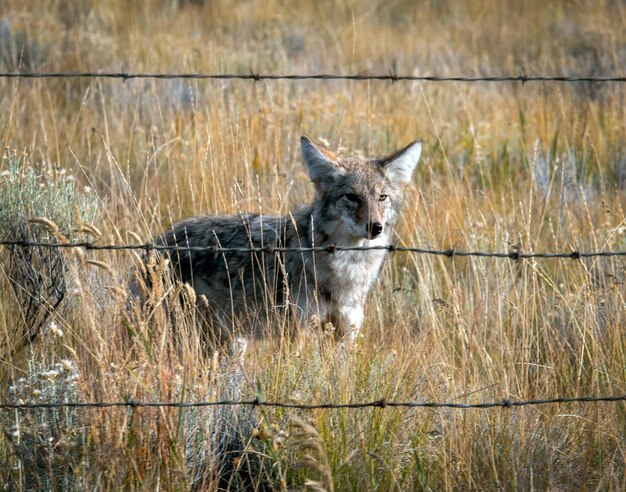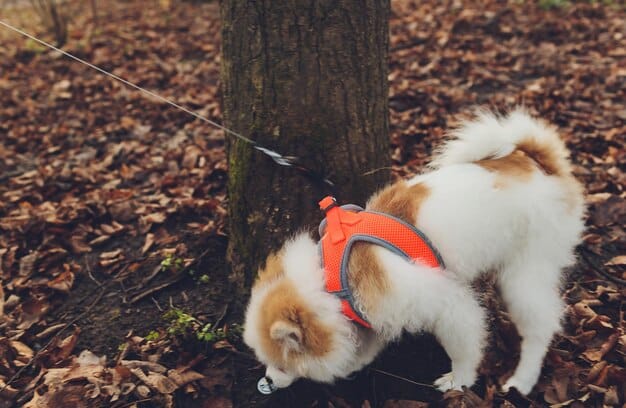Coexisting with Coyotes: Expert Strategies for Safety in US Neighborhoods

Coexisting with coyotes in US neighborhoods requires understanding their behavior and implementing strategic measures such as securing food sources, using deterrents, and educating the community to ensure the safety of families and pets.
Living near coyotes can be concerning, but peaceful coexistence is achievable with the right strategies. This article provides expert advice on coexisting with coyotes: expert strategies for keeping your family and pets safe in US neighborhoods, ensuring a harmonious environment for everyone.
Understanding Coyote Behavior in Urban Areas
Coyotes, adaptable creatures, have increasingly made their presence known in urban and suburban landscapes across the United States. Understanding their behavior is fundamental to coexisting safely.
Recognizing why coyotes are drawn to residential areas and discerning their common behavioral patterns can significantly mitigate potential conflicts.
Why Coyotes Enter Neighborhoods
Coyotes primarily enter neighborhoods in search of food and shelter. Understanding these motivations is crucial for effective prevention.
- Food Availability: Unsecured garbage cans, pet food left outdoors, and fallen fruit attract coyotes.
- Habitat Loss: As natural habitats shrink, coyotes seek refuge in urban areas.
- Easy Prey: Small pets, rodents, and other easily accessible prey draw coyotes to residential areas.
Common Coyote Behaviors
Knowing how coyotes typically behave can help residents react appropriately and avoid escalating encounters.

- Crepuscular Activity: Coyotes are most active at dawn and dusk.
- Territoriality: Coyotes defend their territories, especially during mating season.
- Adaptability: They quickly adapt to human presence, becoming bolder over time if not deterred.
By acknowledging these behaviors, residents can take proactive steps to reduce the likelihood of negative interactions and foster a safer environment for both humans and wildlife.
Securing Your Property to Deter Coyotes
One of the most effective ways to coexist with coyotes is to secure your property, minimizing opportunities that attract them. Simple modifications can make a significant difference.
From managing food sources to improving physical barriers, there are several proven methods to deter coyotes from entering your property.
Managing Food Sources
Reducing the availability of food is a cornerstone of coyote deterrence. Here are some steps to follow:
- Secure Garbage: Use trash cans with tight-fitting lids and store them in a garage or shed.
- Pet Food Storage: Never leave pet food outside, and store it in sealed containers.
- Clean Up Fruit: Regularly collect fallen fruit from trees in your yard.
Enhancing Physical Barriers
Physical barriers prevent coyotes from easily accessing your property. Consider these modifications:
- Install Fencing: A fence at least 6 feet high can deter coyotes. Add a coyote roller or leaning section to prevent climbing.
- Motion-Activated Lights: Install lights that activate when motion is detected, startling and deterring coyotes.
- Netting: Use bird netting to protect fruit trees and prevent coyotes from accessing fallen fruit.
By implementing these measures, homeowners can significantly reduce the attractiveness of their property to coyotes, promoting a safer and more harmonious coexistence.
Protecting Your Pets from Coyote Encounters
Pets, especially small dogs and cats, are particularly vulnerable to coyote attacks. Taking proactive steps to protect your pets is essential for responsible pet ownership.

Understanding coyote behavior and implementing preventive strategies will help keep your beloved animals safe.
Supervising Pets Outdoors
Constant supervision when pets are outside is crucial, especially during dawn and dusk when coyotes are most active.
- Keep Pets on Leashes: When walking pets, use a short leash to maintain control and prevent them from wandering off.
- Accompany Pets in Yards: Never leave pets unattended in yards, even if fenced. Coyotes can jump over or dig under fences.
- Use Loud Noises: Carry a whistle or air horn to scare away coyotes if they approach.
Creating Safe Outdoor Spaces
Modifying your yard to create secure spaces for your pets can reduce the risk of coyote attacks.
- Build a Secure Run: Construct a fenced enclosure or kennel for pets when they are outside unsupervised.
- Install Coyote Rollers: Equip fences with coyote rollers to prevent coyotes from climbing over.
By taking these precautions, pet owners can minimize the risk of coyote attacks and ensure their pets’ safety in coyote-populated areas.
Effective Hazing Techniques to Deter Coyotes
Hazing, or actively deterring coyotes through non-lethal methods, can be an effective way to teach them to avoid human areas. Consistency is key for success.
Understanding appropriate hazing techniques and implementing them regularly can reinforce a coyote’s fear of humans and residential areas.
Understanding Hazing
Effective hazing involves using assertive actions to make coyotes uncomfortable and encourage them to leave an area.
- Be Assertive: Stand tall, make eye contact, and act confidently.
- Use Noise: Yell, clap your hands, blow a whistle, or use an air horn.
Implementing Hazing Techniques
Combine noise with other deterrents to create a more effective hazing experience for the coyote.
- Throw Objects: Toss small objects like tennis balls or rocks towards the coyote, but not directly at it.
- Spray Water: Use a hose or water gun to spray the coyote.
- Use Visual Deterrents: Wave a large stick or umbrella to appear larger and more intimidating.
Regular and consistent hazing will teach coyotes to associate humans and residential areas with negative experiences, making them less likely to approach in the future.
Educating Your Community About Coyote Awareness
Coexistence with coyotes requires a community-wide effort to promote awareness and responsible behavior. Education is a powerful tool in achieving this goal.
Community education programs can teach residents how to minimize attractants, react appropriately to coyote sightings, and report incidents to the relevant authorities.
Organizing Community Workshops
Workshops can provide valuable information about coyote behavior, safety tips, and best practices for coexistence.
- Invite Experts: Include wildlife biologists, animal control officers, and experienced residents as speakers.
- Cover Key Topics: Discuss coyote behavior, hazing techniques, and property management strategies.
- Offer Practical Advice: Provide hands-on demonstrations of hazing techniques and property modification tips.
Sharing Information Online and in Print
Disseminating information through various channels ensures that all residents have access to essential knowledge.
- Create Informative Materials: Develop brochures, flyers, and website content that provide clear and concise information about coyotes.
- Utilize Social Media: Share tips, updates, and stories on community social media pages.
- Partner with Local Media: Work with newspapers, radio stations, and television channels to raise awareness about coyote coexistence.
By educating the entire community, residents can work together to minimize conflicts and foster a safer environment for both humans and wildlife.
Understanding Local Laws and Reporting Coyote Sightings
Familiarizing yourself with local laws and reporting coyote sightings is crucial for effective wildlife management. Awareness of regulations can help you act responsibly and contribute to community safety.
Knowing how to report coyote sightings and understanding your rights and responsibilities can help ensure that wildlife management efforts are effective and responsive to community needs.
Identifying Local Regulations
Each jurisdiction has its own set of rules and regulations regarding wildlife management. Be aware of these:
- Check Local Ordinances: Review city and county ordinances related to wildlife feeding, trapping, and harassment.
- Understand State Laws: Familiarize yourself with state laws governing wildlife management and hunting.
- Contact Local Authorities: Reach out to local animal control or wildlife agencies for clarification on specific regulations.
Reporting Coyote Sightings
Reporting coyote sightings, especially those involving aggressive behavior, can help wildlife agencies monitor populations and address potential issues.
- Contact Local Animal Control: Report sightings to your local animal control agency.
- Provide Detailed Information: Include the location, time of day, and behavior of the coyote.
- Notify Neighbors: Inform your neighbors about the sighting so they can take appropriate precautions.
By understanding and adhering to local ordinances and reporting sightings, residents can contribute to informed wildlife management and promote safer coexistence.
| Key Area | Brief Strategy |
|---|---|
| 🏠 Secure Property | Manage food, enhance barriers (fences, lights). |
| 🐾 Protect Pets | Supervise outdoors, create safe spaces. |
| 📢 Community Awareness | Educate neighbors, report sightings. |
| 🚨 Local Laws | Adhere to regulations; report incidents. |
Frequently Asked Questions
▼
Coyotes are attracted to residential areas primarily by the availability of food sources, such as unsecured garbage, pet food left outdoors, and small animals like rodents.
▼
Keep pets indoors, especially at dawn and dusk. When outside, keep them on a leash and supervise them closely. Consider installing a secure fence or pet run.
▼
Hazing involves using loud noises, assertive body language, and thrown objects to scare coyotes away. Consistent hazing teaches them to avoid humans and residential areas.
▼
If a coyote approaches, haze it by making loud noises and acting assertively. Report the sighting to your local animal control agency, especially if the coyote is aggressive.
▼
Organize workshops, share informative materials online and in print, and partner with local media to educate residents about coyote behavior and safety tips.
Conclusion
Coexisting with coyotes requires a proactive and informed approach, focusing on securing properties, protecting pets, implementing hazing techniques, and educating the community. By taking these measures, residents can minimize conflicts and foster a safer environment for both humans and wildlife.





